I took this photo: They must have been closed
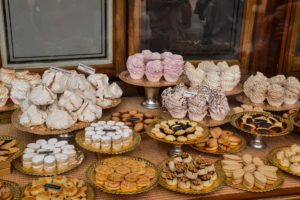
Dive through the window
I took this photo but I didn’t eat a single thing.
They must have been closed.
I can think of no other explanation.

Dive through the window
I took this photo but I didn’t eat a single thing.
They must have been closed.
I can think of no other explanation.
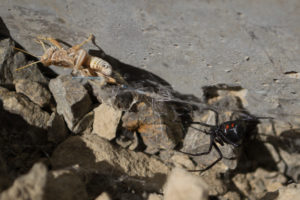
Life and death. Eeny, meeny, miny, mo, catch a grasshopper by the toe.
There are good days. There are bad days.
Some days you’re a black widow spider on top of your web. The world is at your feet, and it fears you.
Other days, you’re the grasshopper, caught by the most delicate thread and just by the toe. Yet, each time you hop away, you land in exactly the same place.
I took this photo on a day when I was perceived as the spider – though I felt like the grasshopper. Gratefully, those days are past.
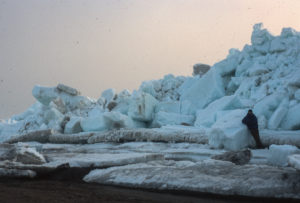
Things that happen while you sleep.
Unless the weather was completely unbearable I left the tent door partially unzipped so I could sit up and look out. My theory was if a polar bear was calling, I wanted to see it before it pounced. Of course, zipped into my sleeping bag, I looked like a puffy seal and an easy snack for a bear (granted in the photo above, out of my sleeping bag, I look like a puffy upright seal).
Sometimes while I slept people would stop on the island. They would pull up their boat, walk to the tent, see me buried in my bag, and leave again. Occasionally, I awoke to a plate of donuts or fresh fish left by unknown visitors.
When you live alone in a tent on an Arctic Ocean island you might expect heightened senses and light sleep. Hearing a boat approaching the island or a bear approaching your tent would be a good survival skill.
I took this photo after a good night’s sleep. I crawled out of the tent to find that the Arctic Ocean had moved thousands of tons of ice into this massive wall less than a hundred yards from where I slept.
It’s amazing I survived at all.
[This is a scan from the original slide. From film. Some of you may remember that stuff.]
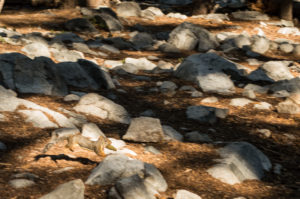
Fall caching; squirrel on the move.
This is a cautionary tale.
A chipmunk spent its morning trying to pilfer any bit of food it could find from my campsite. The food was packed, hung, and covered. There were no bits lying around, no dirty dishes, no tossed veggie scraps. The chipmunk tried every angle, checked every stuff sack and container to no avail.
Meanwhile, a squirrel spent its morning dashing through the campsite. It collected cones in trees near the lake, ran through camp with a cone in its mouth, and then into the alders along the edge of the lake’s outflow meadow. A few minutes later, having stashed the cone in some secret place, it would run back to camp, stop to look at me over my pack or across the fire ring, and then continue on its path. It didn’t disturb any of my things or even sniff at the stuff sacks. Every five minutes it made another roundtrip through camp.
After a couple of hours, the chipmunk was still angling for something easy and free, although it seemed to have less enthusiasm at this point. It stopped to scold me occasionally as if to say, “How dare you! Where is my breakfast?” It would disappear for ten or twenty minutes and then reappear to once again check every item. Just in case.
The squirrel also scolded me but it was because I inadvertently stepped into its path when it was crossing camp. Halfway through the morning, the squirrel stopped for a snack – a cone he found near one of his supply trees – and then went back to work.
Returning to my briefly unguarded teacup, I found two tiny droplets on the rock next to it. Inside the rim of the cup, there were two little, wet paw prints. The cup was otherwise undisturbed, not knocked over, no floating debris, just two perfect paw prints.
I took this photo by predicting the squirrel’s movement along the same path through camp. It was reliable, as is his winter food supply. The chipmunk only got wet feet for his morning’s work.
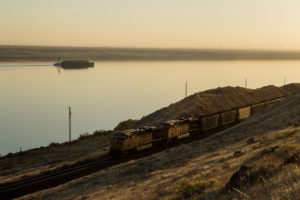
Twilight on the surface
The main stem of the Columbia River has 14 dams on it, including the largest dam in the United States. Within the entire Columbia basin, more than 400 dams generate almost half of the hydropower in the US.
Ship locks at several dams and channel dredging allow navigation from the Pacific Ocean to Lewiston, Idaho – more than 400 miles inland.
In the late 1800s, half a million salmon were caught for canning and export in one season. Today four of the 400 dams have fish ladders.
The river irrigates 670,000 acres of sagebrush desert in Washington. As many as 100 illegal dams on private property irrigate an unknown number of additional acres.
Hanford, a Cold War plutonium production site, is the most contaminated nuclear site in the US. For 27 years radioactive cooling water from the eight plutonium production reactors was released back into the Columbia River. The federal government did not disclose this information until more than a decade after the discharge ceased.
Today, an estimated 270 billion gallons of groundwater have been contaminated by high-level nuclear waste that leaked from Hanford’s storage tanks. A million-gallon plume of that radioactive groundwater is expected to hit the Columbia River within the next 10 years at the earliest and 50 years at the latest.
I took this photo in the fading evening light of a typical Columbia River day. Train tracks, carrying coal and oil trains, parallel both banks; grain and coal barges ply its waters; Interstate 84 flanks its south shore; thousands of wind turbines, just visible on the far shore, stand sentinel to the north and south; the slow, warm, slack water impounded behind another dam holds fish that can’t move downstream fast enough and can’t move upstream at all; the final ingredient in the cocktail is three decades of nuclear waste in the water and sediments. The calm water and the pastel light are a lovely façade on a tenacious, living body of water that miraculously continues to survive.